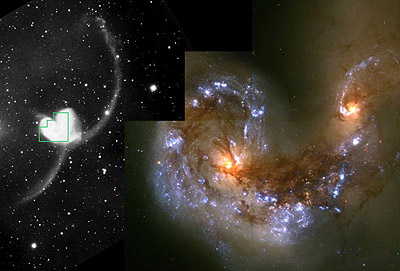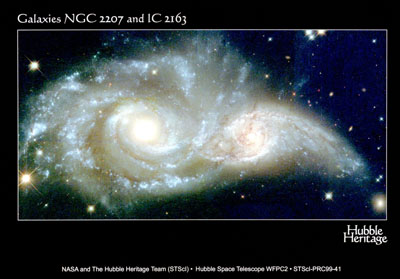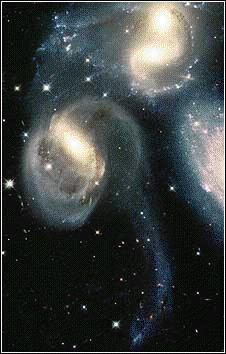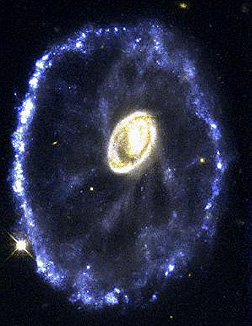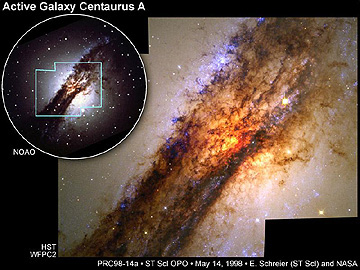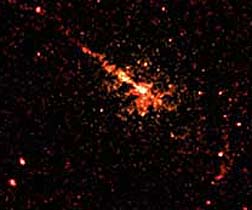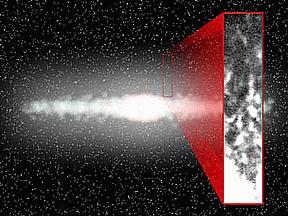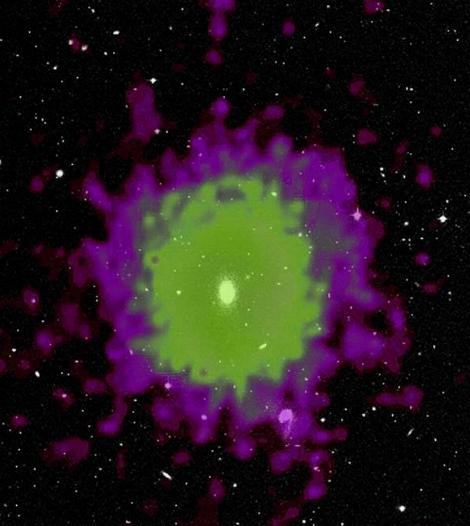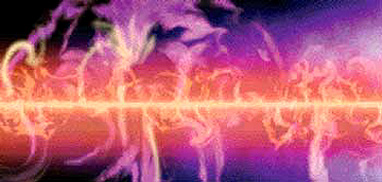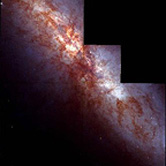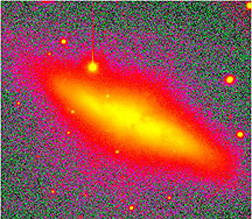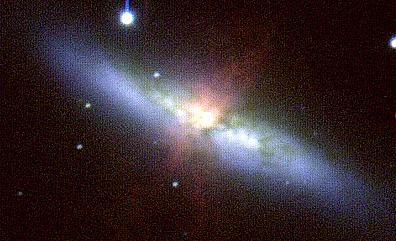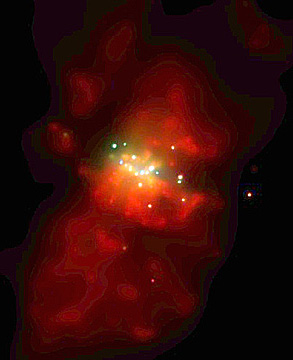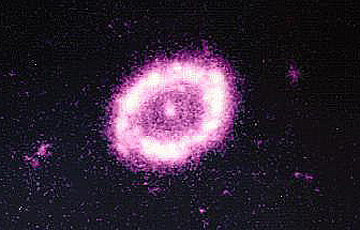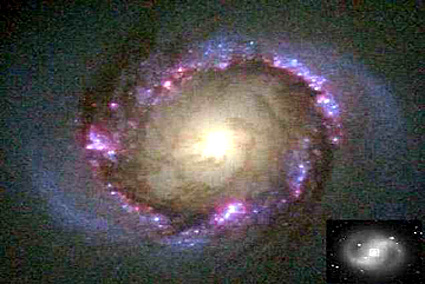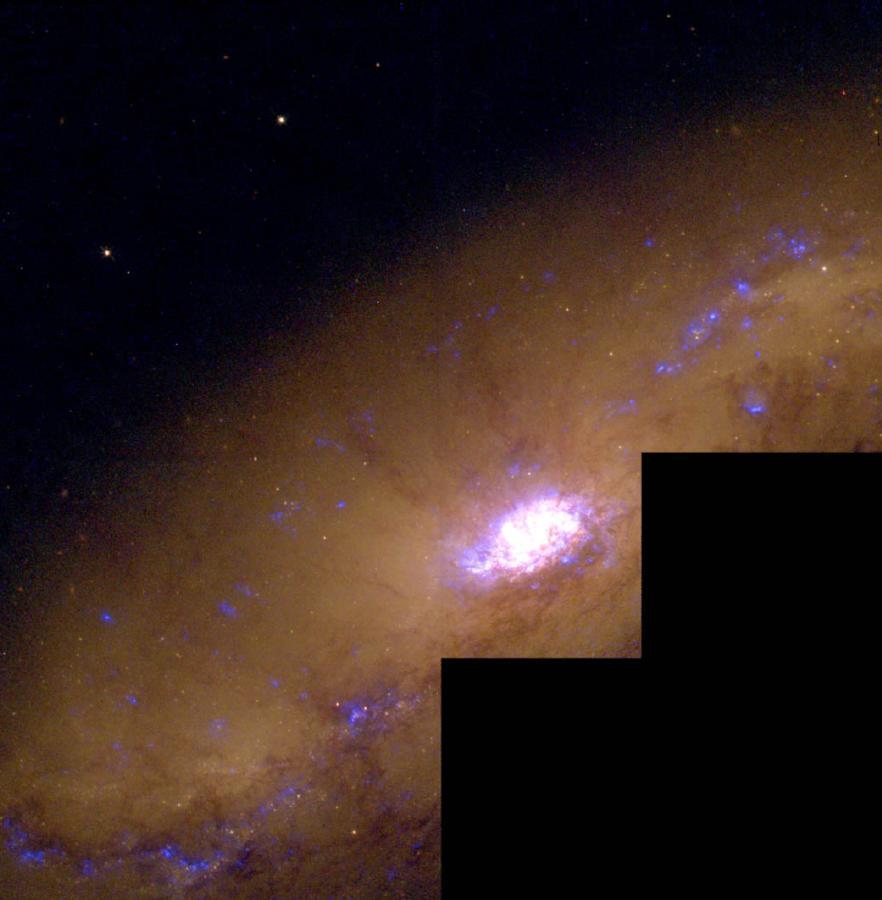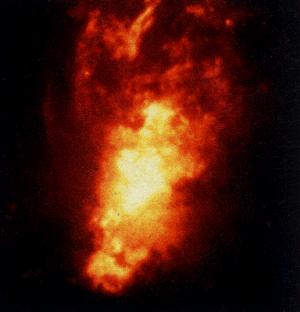Special Features of Galaxies¶
Contents
Special Features of Galaxies
Colliding Galaxies
A release on October 21, 1997 from one of the HST research teams describes important new information on star formation within an evolving galaxy system. Examine this pair of telescope images of the Antennae galaxy:
The left one is a ground-based telescope view of two colliding galaxies which together make up what is called the Antennae galaxy, so-named from the long wisps of luminous gas extending like an insect’s antennae. Because of its proximity (63 million light years away), it has been a prime candidate for a closer look. The right image is a much higher resolution HST view of the central galactic mass (green box outline) of merged stars from the two once separated galaxies. The surprise is the numerous clusters of blue stars. Each appears to be groups of up to a million young (hence bright and hot) individual stars. The clusters likely are still developing, as cold hydrogen gas in giant molecular clouds (typically 100s of light years across) distributed in pockets through each galaxy are being squeezed during the collision process. They contract and heat up into individual stars as this goes on, often collapsing rapidly enough for many of the stars to explode almost like “firecrackers”. Other pre-existent stars are likely to be destroyed as the collision continues. The two orange centers are the older surviving parts of each galaxy.
Still another spectacular collision seen by HST is that just beginning between NGC2007 and IGC2163. As the two merge, most individual stars will not collide with another star, since in any such galaxy the distance between stars is actually huge, lessening the changes of direct collisions (although as the pair of galaxies pass through, any given star must always face the possibility of encounter with a star somewhere along their mutual paths):
These observations support the growing view that collisions were a more common process in the early Universe (but still happen even now). Perhaps as many as one-third of the ancient galaxies collided during the lengthy period when galaxies were much closer, i.e., Big Bang expansion was less far along. Sometimes more than two galaxies are involved in the colliding process. One solid indication of collisions is the notable irregularity of the galaxy composite, with irregular center(s) and distorted spiral arms. These three HST examples of multiple collisions, imaged in the infrared, illustrate that:
In this recent image, made by combining images obtained by the NICMOS and ACS sensors, 4 galaxies can be resolved individually. As a pair merge, the increased gravitational attraction of the composite can draw in nearby galaxies to foster further enlargement of a galactic grouping.
Another well known grouping of close-spaced galaxies that appear to be headed for some kind of amalgamation is Stephan’s Quintet, with three of the five seen in this HST view:
The Seyfert Sextet is a group of six galaxies, 190 million light years away in the constellation Serpens. They consist of 3 ellipticals and 3 spirals (only five visible in this orientation; the small spiral galaxy seen face on is not in this group, being much more distant). None of the galaxies is more than 35000 l.y. across. This configuration has been interpreted as a congregation of galaxies in the process of colliding and being ripped apart by gravitational interaction. The elongate bright central areas in two regions of the cluster may be the cores of merging pairs of galaxies. Unlike some colliding galaxies, there is no visible evidence of bright new stars being formed in these phases of collision.
This next pair of spiral galaxies are also starting their collision interactions. Note the stream of gas and dust between them. Stars are forming in this bridge.
The usual end product of the merging of two spiral galaxies is an elliptical galaxy; many elliptical galaxies formed this way. Collisions can also give rise to spiral structure. Some globular clusters also presumably originated from interactive collision.
One of the more visually intriguing results of a collision is the Cartwheel Galaxy (below), another Ringed Galaxy, in which the passage of one galaxy through another generated shock waves traveling at high velocities. As these waves moved outward, they condensed hydrogen into a huge collection of new stars that lie along the front of the advancing waves:
Galaxy collisions can release copious amounts of energy. The Chandra X-Ray telescope (next page) has detected a huge release of x-rays at the elliptical galaxy NGC 1700, located 160 million light years from Earth:
At 90000 light years in diameter, this x-ray source is the largest yet discovered in the Universe. The emissions come from a vast spinning cloud of hydrogen gas excited to temperatures in excess of 8 million degrees. Astronomers studying this cloud surmise that the collision was between a spiral and an elliptical galaxy.
The circular inset shows Centaurus A as seen optically through a ground-based telescope. The detailed view to the right was acquired by HST’s Wide Field Camera. An elongate disc, marked by dark dust, is spread across a large white glow that is identified as an elliptical galaxy. This pairing is interpreted to be an intermingling of a spiral galaxy in collision with this elliptical galaxy. The Infrared Camera on HST can penetrate the dust to reveal a hot, turbulent mass of stars, dust and gas from the spiral galaxy falling into the core of the elliptical one, as seen in the larger view.
The Chandra X-ray telescope (page 20-4) captured an unsuspected feature of Centaurus A - namely, a jet of material ejected to a distant of 25000 l.y. from the core. This single jet of intense x-ray energy is roughly at right angles to the plane of the disc.
A Black Hole (see page 20-6) is postulated to occur towards the center of the two interacting Centaurus systems. This B.H. may be as massive as 10 billion solar masses, occupying a volume similar to our Solar System. The Black Hole is “sucking” matter from both galaxies into its growing body. This set of observations is the most detailed yet of the consequences of galactic collisions.
One model of future Universe expansion paths indicates that the nearby Andromeda spiral galaxy could come close to our Milky Way galaxy and might even collide with us. There is considerable recent evidence that a small galaxy is presently passing through the Milky Way. Known as the Sagittarius dwarf spheroidal galaxy (or Sgr), its presence has been deduced from motions of certain stars that do not fit the motions of M.W. stars in the spiral arms; also star “tails” stretch out in the galactic halo, suggesting that Sgr is in a broad orbit that has caused it to intersect the Milky Way before. The vast distances between stars keeps interactions to a minimum.
Galactic Gas
(Note: this subsection was added in January 2002, in response to information summarized in an article for that month in Scientific American by Ronald J. Reynolds, entitled “The Gas between the Stars”. It is placed on this particular page, as an addendum to page 20-2, with relevance also to page 20-5, partly because the present page 20-3 has less text and illustrations than the other two and will therefore download over a shorter time than those pages which contain many more illustrations.)
Seemingly empty regions of space - both within and between galaxies -actually contain variably small quantities of matter. The population of identifiable matter (molecules; protons, photons, cosmic rays, etc.) can be very small in space between galaxies and their halos. Dark matter (described on page 20-10), of presently unknown nature, is also present. For elements, the dominant species is hydrogen, present as several types; helium is present at about 10% and the higher atomic number element species together constitute only a fraction of 1%. In galaxies, these elements make up what has been termed an “atmosphere” to describe the gases and particles not in the associated stars. The dominance of hydrogen within galaxies is evident from this NICMOS Hubble Space Telescope image of NGC 4013, taken at a infrared wavelength in which hydrogen appears to glow red:
Galactic Hydrogen occurs in the following states within the nebulae present in both the central midplane and to a much smaller extent in the halo : 1) neutral hydrogen (H:sub:I), found mainly in the central midplane of a galaxy, which has a temperature ~120°K; it is responsible for giving off the 21 cm radiation (1420 MHz) used by radio astronomers to map its distribution; 2) molecular hydrogen (H:sub:2), with a temperature around 15°K, which, although it comprises only 18% of all hydrogen in the galaxy, is concentrated mostly in the gas nebulae in the central plane and is the principal material that organizes into stars; its distribution is mapped both in the 2.2 µm and the far UV regions of the EM spectrum. Outside the gaseous nebulae and predominantly in the halo, the hydrogen exists in three states, brought about by their higher kinetic temperatures: 1) warm H(I), T = less than 3000°K, about 30% of all the hydrogen in the galaxy, extending out to 33000 light years (ly); 2) warm H(II), ionized (loss of electron), T =3000-10000+°K, 35% of the hydrogen, extending out to about 65000 ly; 3) hot H(II), also ionized, T = upwards of 1 million degree K, present at low densities out to about 180000 ly, and making up about 45% of all hydrogen. Thus, it is now known that nearly all ionized galactic hydrogen is located beyond the central plane, i.e., in the halo, but make up about 22% of the mass; the stars themselves account for only about 2% by volume but 30% of the mass; the remaining mass is represented by H(I), 35% of which is in the halo and 0.1% in the clouds. To restate this: a spiral galaxy is mostly hydrogen with some present in stars concentrated in the central plane but also found in smaller numbers in the halo which itself is composed of neutral and ionized hydrogen whose temperatures are much higher than the hydrogen gases within the central plane. (More discussion of the different types of hydrogen gas will appear on pages 20-5 and 20-7.)
Clouds of hydrogen in the halo region of the Milky Way have been imaged in the infrared. In this next illustration, a view of these clouds is shown in the vertical strip to the right; the side-on image of the Milky Way is an artist’s rendition rather than an actual observation.
An idea of just how far beyond a galaxy’s gas extends into a halo is evident in this illustration in which a visible light image of the galaxy itself (center, elliptical) is registered to an x-ray image that displays the tenuous gas (which can reach temperatures here up to 1000000° K) extending to great distances outward diameter to purple edge = 1.9 million l.y.). The purple and green indicate two arbitrarily-divided levels of x-ray emission.
This atmosphere is somewhat analogous to that on Earth (decreasing in density upward) in that its hydrogen constituents drop in numbers (again, descreasing in density outward) as the outer reaches of the halo are approached. Like the atmosphere of Earth, and similar also to that surrounding the Sun, the galactic atmosphere is dynamically and continuously active. Both within the star-forming region of the central plane and, to a lesser extent in the inner halo, this gas is perturbed by shock waves and expelled particles in stellar winds, generated mainly by supernovae explosions (page 20-6). Many of these explosions are associated with massive, short-lived stars (the O and B types described on page 20-5). The result is “turbulence” driving some matter into denser clots (initiating regions of new star formation but also producing volumes of much lower hydrogen concentrations called “bubbles”. Conceptually, the galactic atmosphere could be visualized as looking a bit like Swiss cheese, with holes where the bubbles occur.
Indications are that (mostly ionized) hydrogen is expelled as a plasma from the central plane region after supernova events in streamers that are given the descriptive name “columns” and resemble the flares jetted out from the Sun (page 20-5). They may start as bubbles which rise thermally and draw in hydrogen gas as they pass into the halo. These move out to distances in excess of 10000 ly, but tend to break up with some material returning to the plane as more diffuse “fountains”. (Their outward pathways may be controlled by a galactic magnetic field). This predicted phenomenon has not yet been imaged (so its existence is still not proved) but here is an artist’s depiction of what it might look like in our Milky Way galaxy (compare this to the illustrations of the Milky Way imaged at various wavelengths on the next page (20-3):
From Scientific American, January 2002
A survey of gas densities around the Sun in our part of the Milky Way is being carried out by ground telescopes, by FUSE (Far Ultraviolet Spectrometer Experiment), and by CHIPS (Cosmic Hot Interstellar Plasma Spectrometer; also operating in the far UV). In May of 2003, a group at the University of California, Berkeley, and French colleagues, produced maps of the densities out to 1000 light years, as follows:
The left map is a section perpendicular to the plane of the M.W.; the right map is a cross-section through the left map in the plane. The light-toned areas are regions of very hot gases (kinetic temperatures in the 1 million degrees Kelvin range) with lower than average intragalactic densities. The dark-toned areas are higher density, lower temperature regions. The reason for the low density “bubble”, actually roughly chimney-shaped with protuberances, is still uncertain. One hypothesis turns to a supernova explosion in the past that may have produced “galactic winds” that blew intragalactic material out of the resulting low density region. At such low densities, atoms of hydrogen can move greater distances without collisions and thus attain higher kinetic temperatures.
These studies of the processes involving galactic atmospheres are opening up new insights into the factors that lead to star formation during the lifetime of a galaxy. Some examples of chimneys in nearby galaxies have been imaged by the Hubble Space Telescope and other observatories. Research along the lines described above is likely to improve our understanding of the activities within galaxies that determine their history.
Starbursts and the Active Galactic Nucleus
These topics have already been introduced on pages 20-2 and 20-2a. However, an article entitled The Galactic Odd Couple by Goddard Astronomer Kimberly Weaver in the July 2003 issue of Scientific American contains so much information new to the writer that I have decided to add this subsection, presented as a synopsis in much the order followed in her paper.
Weaver’s main thesis is that both Starbursts and AGNs are commonplace in galaxies and each seems interdependent in several possible ways on the other and on Black Holes. Furthermore, the two represent the most powerful release of energy (strong in every segment of the EM spectrum) at galactic scales (hypernovae and gamma ray bursts are tops in power output at individual star scales) now known in the Univese.
Let’s commence by looking at various manifestations of starbursts. We will concentrate on M82, the “Cigar” galaxy, which has been classified as irregular but tends to be lenticular. This irregular starburst galaxy is small (about 16000 light years across) and is located about 11 million l.y. from Earth. It is rated as one of the brightest galaxies ever found and is visible to the naked eye in the constellation Ursa Major. Because so much data and imagery have been collected at different wavelengths, this is a good moment to look at how this galaxy appears in various parts of the spectrum (as just discussed on page 20-3). First, let’s set it in context to its surroundings. M82 is part of a triad of galaxies that includes the larger spiral M81. Many astronomers interpret this proximity to indicate that M82 may have collided ( or may eventually) with M81 and has spun off the third smaller galaxy NGC3077) as a result. Witness:
Here is a HST optical range (visible) image of M82. There is no single central core of dense stars as is customary with spiral galaxies. Instead of spiral arms the outer regions seem to contain formless clouds of dust and gas. And in this rendition the central region seems no brighter than the outer parts.
An HST Wide Field Camera view of the off-center region looks like this; note the brighter central area:
The next image is not too informative but is so colorful that it is inserted just for your inspection. This is a false-color rendition of M82 visible imagery, made by Greg Bothun of the University of Oregon.
The next pair of images were taken through HST (top) and the Japanese Subaru ground telescope using the H-alpha excitation line as one of the color input bands. Both show a hotter interior with a central jet emerging normal to the plane of the galaxy.
The Chandra X-ray Telescope (page 20-4) presents this image of M82, again showing some of the starbursts.
A very different appearance is displayed in this Ultraviolet image of M82
As seen in the infrared, M82 shows the hotter regions to be lenticular in shape and located in the inner part of the galaxy
This radio telescope image of M82 shows a number of bright areas which are interpreted to be starburst regions.
Another radio telescope rendition of M82, in which the areas of varying emission are shown as color-coded. The reds and yellows denote the strongest signals.
This is a timely moment to think about M82 in the context of the general figure illustrating Galaxy Anatomy shown near the middle of page 20-2. The continuous central yellow area, which contains a much denser collection of stars, and accretion disk, a black hole, and an outward jet, is the Active Galactic Nucleus. Various blue stars surround the AGN.
A few more examples of starbursts should affix their appearance and characteristics in your mind.
The first image shows a central starburst cluster in galaxy NGC 3603. Below it is a ring of stars in M94, envisioned in the UV. The third image shows a prominent ring of starburst objects just out from the center of galaxy NGC 4314.
This image of NGC1808 shows a well-defined AGN that may contain unresolved starburst stars as well. Beneath it is NGC9812, showing a mix of AGN excited gas and some star bursts.
|The central part of NGC9812, an irregular AGN mixed with star bursts. |
One of the more thoroughly examined AGNs is NGC1068, shown here in the infrared:
Now to the meat of Dr Weaver’s paper.
While Black Holes come in all sizes, the larger ones (supermassive Black Holes; which nevertheless contain about 0.1% of the total galactic mass) are involved in both AGNs and starbursts. Furthermore, B.H.’s may also be responsible for star formation at slower rates (non-bursts). Suupermassive B.H.’s contain mass up to a trillion times that of the Sun but are only less than 1000 times its diameter. AGNs, as stated earlier, are superbright (although not notably in visible wavelengths), often outshining the rest of a galaxy combined. AGNs are superrich in quasars which individually give off huge quantities of radiation. Many starbursts are as brilliant (in terms of energy given off) as the AGNs. A starburst period of activity is usually about 10 million years in length, during which the rate of star formation is up to 1000 times that of normal creative activity in a galaxy. One likely cause of a starburst is intermingling of gases when two galaxies collide (pass through each other), and the density of gases needed to make the stars increases. Both starbursts and AGN formation were much more prevalent in the first 1-2 billion years of Universe history.
The question arises as to whether starbursts and major activity within an AGN occur simultaneously. Observations show that AGNs are often associated with young, bright, massive stars. Howeve, it is often difficult to demonstrate the presence of starbursts within an AGN since the latter is marked by large amounts of obscuring dust (some of which is tied to the starburst process). The AGN can be “dormant” (no conspicuous visibility) until its gases begin to flow abundantly into the supermassive B.H. Starbursts commonly occur at an early stage of this process. Both starbursts and AGNs can be verified as active by examining their spectral - ionized oxygen and other elements show brighter individual spectral lines.
Four possibilities for the interrelation between starbursts and AGNs - which came first and what causal connections exist between them and between B.H.’s - are cited by Dr. Weaver. We reproduce two schematic diagrams from her Scientific American paper that speak to this:
In the first scenario, AGNs are just manifestations (equivalent to) starbursts and are possibly not set up by Black Holes. The second case postulates coincidence, i.e., no direct causal relation between starbursts and AGNs, even though both exist as separate phenomena. The third option considers starbursts to be caused by the supermassive B.H. pulling enough gas rapidly towards it to provide a denser environment in which many more than average star formation events take place. Thus the star bursts result during the period in which gases also react around the Black Hole to form quasar-rich AGNs. The activity controlled by the B.H. that causes the AGN releases shock waves that aid in star burst formation beyond the inner zone. The fourth mechanism argues that starbursts precede the inception and growth of their associated supermassive Black Hole. As each massive star dies, it evolves into a Black Hole or a neutron star. In time, these many B.H.’s coalesce to form the supermassive B.H. found at or near the center of the galaxy (this subject is treated on pages 20-5 and 20-6). A variant involves collisions of smaller stars that then speed up their lives before exploding into dense cold matter. Generally, this last mode first yields Black Holes of intermediate size (as has been observed in some galaxies) but usually the final outcome is a single large B.H.
But the bottom line in Dr. Weaver’s paper is that supermassive Black Holes, AGNs, and Starbursts are a common, perhaps prevalent, set of components in spiral, perhaps elliptical, and also irregular galaxies.
A good review of AGNs is found at this site
Primary Author: Nicholas M. Short, Sr. email: nmshort@nationi.net
